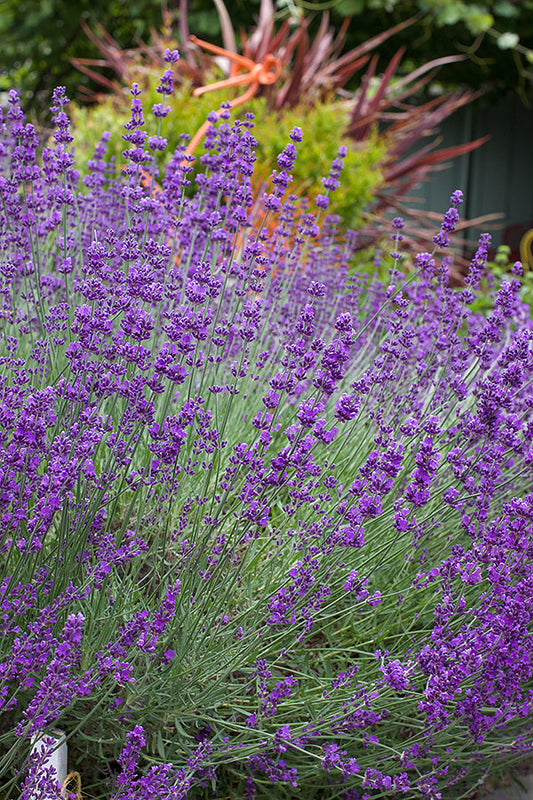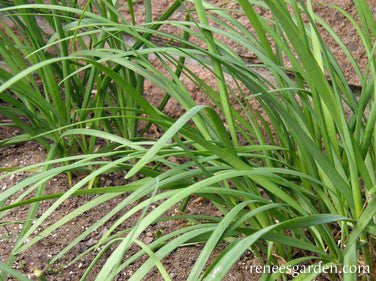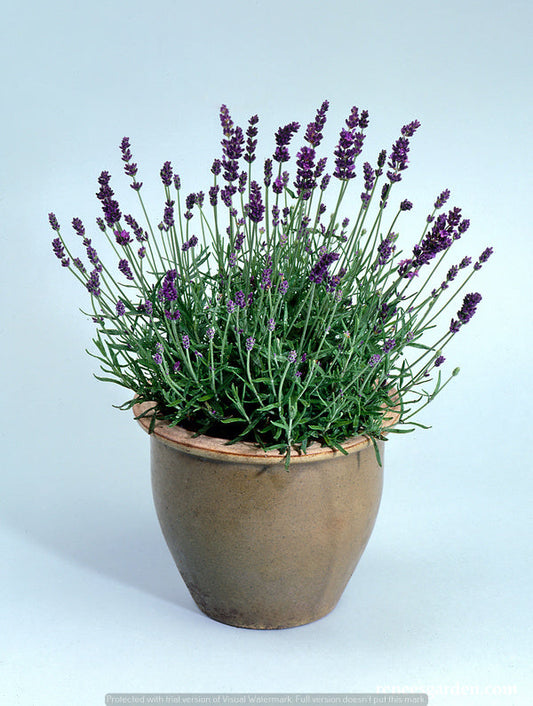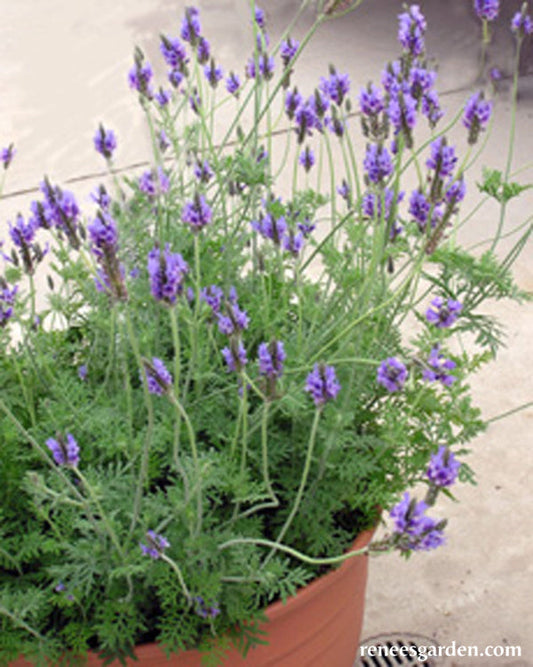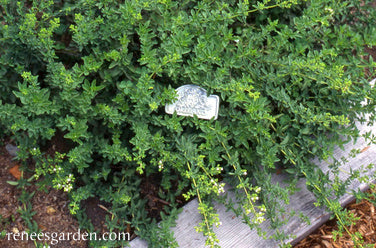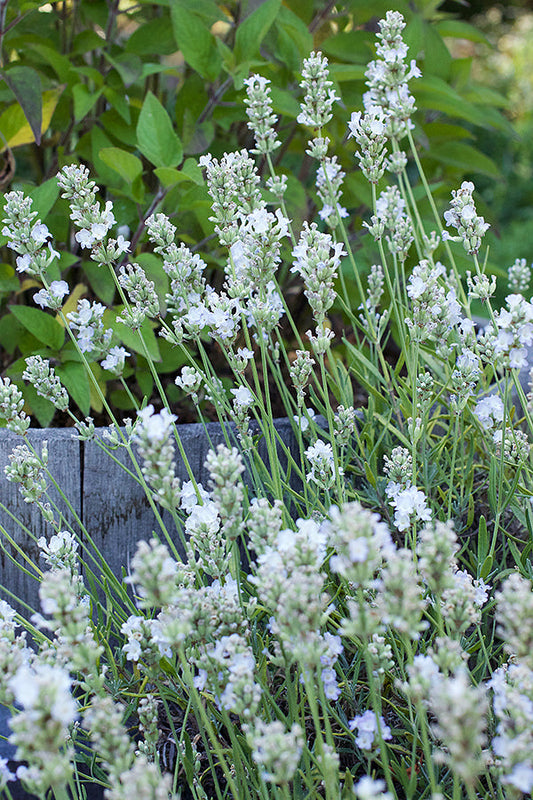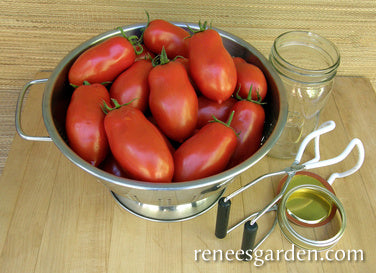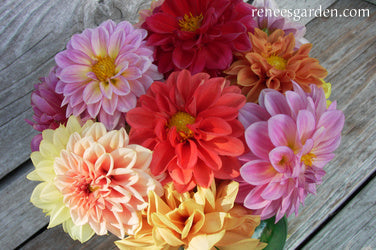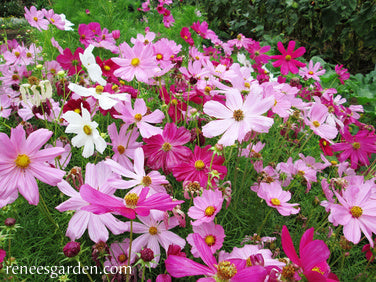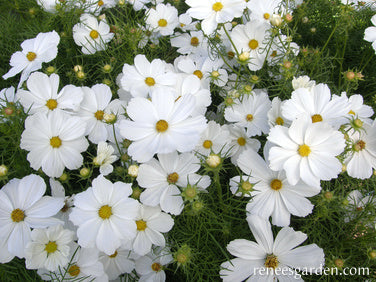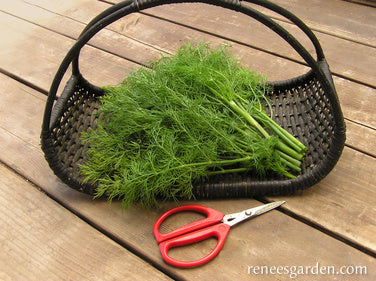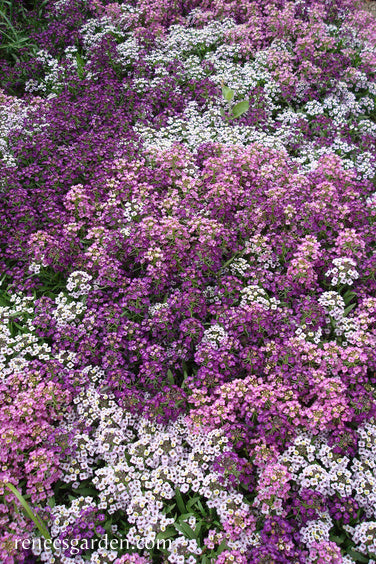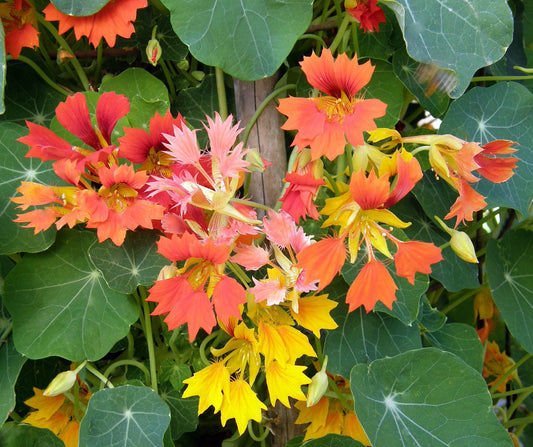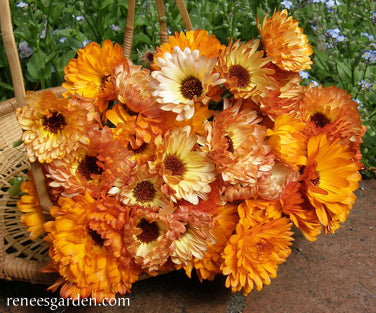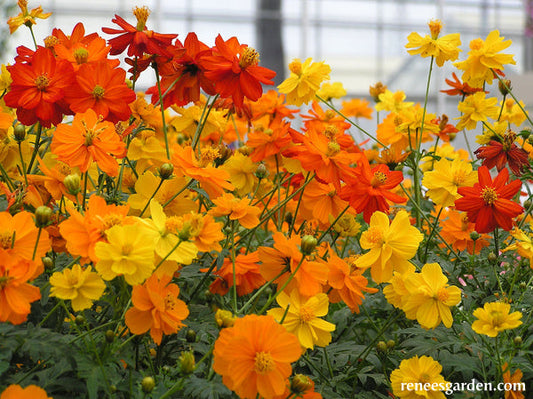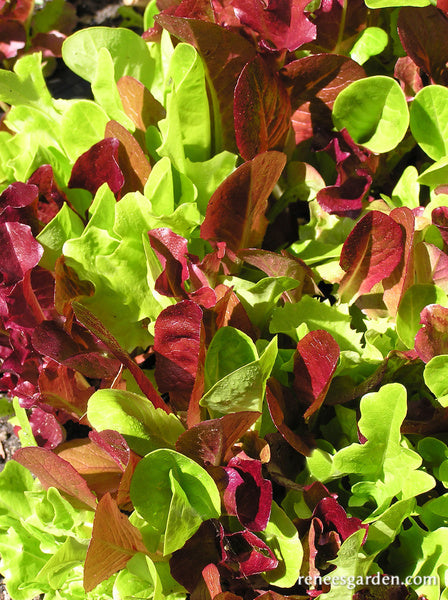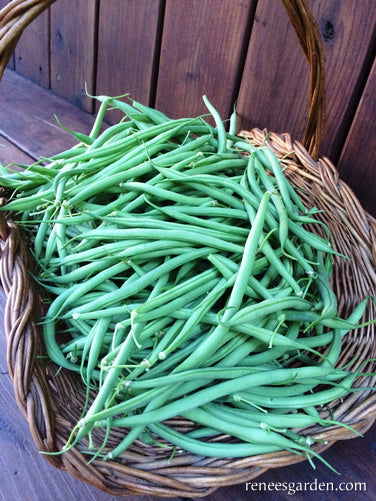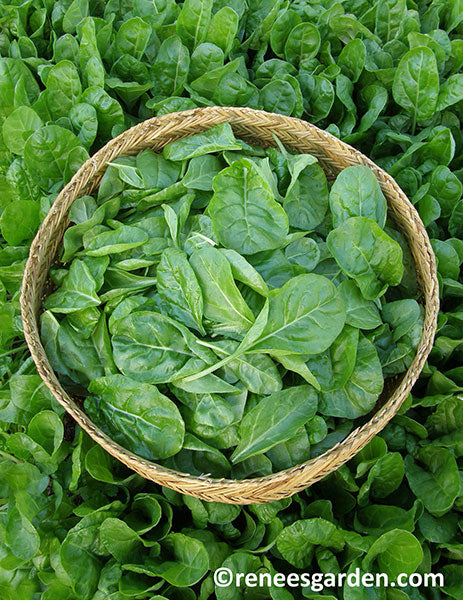Great in Containers
Great In Containers
-
Kitchen Herbs Slow-Bolt Cilantro
ANNUAL
Spring/summer/fall harvest
Can handle light frostsEASIEST TO START OUTDOORS
In early spring, sow Cilantro seed directly into well-drained fertile soil 1 to 2 inches apart in rows 8 inches apart in full sun. Cover 1/4 inch deep and firm soil over seeds. Keep seed bed evenly moist as seedlings emerge over 10 to 20 days. Make new sowings every few weeks until mid summer for continuous harvests of fresh leaves.
THIN OR TRANSPLANT
Cilantro doesn’t transplant well; we advise direct garden sowing. Thin seedlings 3 to 4 inches apart before plants get crowded.
GROWING NOTES
Cilantro plants flower, then set seed quickly as plants mature. Lushest, leafy growth takes place in cooler weather; plant early and throughout cool spring weather and sow again in fall, particularly in mild winter areas. To have a constant supply of fresh leaves, sow every 2 to 3 weeks through early summer.
Keep cilantro at its leafy stage longer by keeping plants well watered and being careful to thin seedlings early. Let some of the lacy flowers form to attract beneficial insects and pollinating bees. The fragrant round seeds are called coriander, an aromatic spice used in baking.
Regular price $2.99Sale price $2.99Unit price / per -
Heirloom Herbs Sweet Marjoram
PERENNIAL
Spring/summer/fall harvest
Frost hardyTO START INDOORS
Sow seed in early spring in a container of seed starting mix. Press gently into mix, but do not cover. Provide a good light source. Keep evenly moist as seedlings slowly emerge in 12 to 21 days. When seedlings are large enough to handle, acclimate gradually to outdoor conditions. Transplant clusters of 3 to 5 seedlings 8 inches apart in full sun.
TO PLANT DIRECTLY IN THE GARDEN
When warm spring weather arrives, sow in full sun in a well-worked, finely textured soil with good drainage. Sow seed as thinly as possible, but do not cover as seeds need light to germinate. Tend carefully, keeping seedbed evenly moist and well weeded. ThIn to leave clusters of 3-5 seedling 8 inches apart.
GROWING NOTES
Mix tiny seed with dry sand to help space seedlings. Young plants grow slowly at first; a good hot spell encourages strong growth. Pick leaves lightly the first season; wait until the second summer to make bigger harvests. Cut blossom sprays off for best leafy growth. Given good drainage, this carefree Mediterranean native is hardy and long-lived.
Regular price $2.99Sale price $2.99Unit price / per -
Scented Herbs Lavender Hidcote
PERENNIAL
Summer/fall bloom
Frost hardyBEST TO START INDOORS
In early spring, sow lavender seeds 1 inch apart in a container of seed starting mix, cover very lightly and keep at 65°F (18°C). Keep container moist but not soggy until seedlings slowly emerge over 14 to 25 days, providing a good light source. When seedlings have several sets of leaves, transplant 2 inches apart into deeper containers. Plant outside in a well-drained sunny spot when plants are 2 to 3 inches tall after gradually acclimating to outdoor conditions.
THIN OR TRANSPLANT
Space seedlings 18 inches apart when large enough to handle.
GROWING NOTES
Because perennial lavender’s small seeds germinate slowly and unevenly, we strongly recommend starting them indoors so you can tend them carefully. After seedlings are well established, plant them out in a sunny spot with excellent drainage and good air circulation or in big, well drained pots. If given excellent drainage and good air circulation, Hardy Hidcote lavender is perennial to Zone 5. Plants flower lightly the first season and come into full bloom by their second summer. After blooming season, prune and shape the plants while cutting off spent flower stalks.Regular price $3.39Sale price $3.39Unit price / per -
Heirloom Herbs Garlic Chives
PERENNIAL
Spring/summer/fall harvest
Frost hardyTO PLANT OUTDOORS
In the cool weather of early spring, sow clusters of 7 to 10 seeds 8 to 10 inches apart in well-worked, fertile soil in sun or part shade. Cover 1/4 inch deep and press soil firmly over seeds. Keep evenly moist as seeds germinate slowly over several weeks. Emerging seedlings have very slender grass-like leaves that mature into mounds.
TO START EARLY INDOORS
In early spring, sow seed thinly in a container of seed starting mix and cover 1/4 inch deep. Keep evenly moist as seedlings slowly emerge and provide a good light source until ready to plant outdoors. Transplant when seedlings are about 2 to 3 inches tall after gradually acclimating plants to outdoor conditions.
THIN OR TRANSPLANT
Space clusters of 7 to 10 seedlings 8 to 10 inches apart.
GROWING NOTES
Garlic chives grow slowly at first, but soon mature into sturdy bright green mounds crowned with pretty white edible blossoms in late spring and summer. After bloom finishes, shear entire plant back to 4 inches to encourage regrowth of tender new leaves. These hardy, self-sufficient plants are attractive additions to the flower or herb garden.
Regular price $2.99Sale price $2.99Unit price / per -
Container Herbs French Perfume Lavender
PERENNIAL
Late spring/early summer bloom
Frost hardy to zone 5 (zone 4 with protection)BEST TO START INDOORS
In early spring, sow seeds about 1 inch apart in a container of seed starting mix, cover very lightly and keep at 60-70°F (16-21°C) in a spot with good air circulation. Keep evenly moist but not soggy. Seedlings emerge slowly and unevenly over 18 to 28 days. Provide a good light source. When seedlings have several sets of leaves, transplant into 4 inch plastic pots. Provide consistent water, but let soil dry out on top between waterings. Feed every few weeks. Plant outside when plants are 2 to 3 inches tall after gradually acclimating to outdoors.
GROWING NOTES
Start these small seeds indoors so you can tend them carefully. When well established, plant seedlings out into pots filled with new potting mix with excellent drainage or in a well drained, sunny garden spot with good air circulation. Plant one seedling per individual pot at least 8 inches wide and deep or space multiple plants 8 inches apart in larger, deeper containers. Feed monthly during the growing season. Plants bloom the first season, but come into fullest flower by the second summer. Harvest stems of scented florets just as they start to open and air dry to use as aromatic sachets. At season's end, shape plants by cutting off spent flower stalks down to top crown of leaves.Regular price $4.99Sale price $4.99Unit price / per -
Kitchen Herbs Fine Leaf Chives
PERENNIAL
Spring/summer/fall harvest
Frost hardyTO PLANT OUTDOORS
In the cool weather of early spring, sow clusters of 7 to 10 seeds about 8 to 10 inches apart in well-worked, fertile soil in sun or part shade. Cover 1/4 inch deep and press soil firmly over seeds. Keep evenly moist as seeds germinate slowly over several weeks. Emerging seedlings have very slender grass-like leaves that mature into mounds.
TO START EARLY INDOORS
In early spring, sow 7 to 10 seeds in individual containers of starting mix and cover 1⁄4 inch deep. Keep evenly moist as seedlings slowly emerge and provide a good light source until ready to plant outdoors. Transplant clusters of seedlings when 2 to 3 in. tall after gradually acclimating plants to outdoor conditions.
THIN OR TRANSPLANT
Space clusters of 7 to 10 seedlings 8 to 10 inches apart.
GROWING NOTES
Chives bear lilac-pink blossoms in late spring and summer. After bloom finishes, cut entire plant back to 2 inches to encourage regrowth of tender new leaves. Given plenty of moisture and a location out of fierce sun, chives are hardy, self-sufficient plants.Regular price $2.99Sale price $2.99Unit price / per -
Spanish Lavender Purple Ribbons
PERENNIAL
Summer/fall bloom
Frost hardyBEST TO PLANT INDOORS
In early spring, sow lavender seeds 1 inch apart in a container of seed starting mix, cover very lightly and keep at 65°F (18°C). Keep container moist but not soggy until seedlings slowly emerge over 14 to 25 days, providing a good light source. When seedlings have several sets of leaves, transplant 2 inches apart into deeper containers. Plant outside in a well-drained sunny spot when plants are 2 to 3 inches tall after gradually acclimating to outdoor conditions.
THIN OR TRANSPLANT
Space seedlings 18 inches apart when large enough to handle.
GROWING NOTES
Because perennial lavender’s small seeds germinate slowly and unevenly, we strongly recommend starting them indoors so you can tend them carefully. After seedlings are well established, plant them out in a sunny spot with excellent drainage and good air circulation or in big, well-drained pots.
If given excellent drainage and good air circulation, Spanish lavender is perennial in areas where winter temperatures stay above 10°. Plants flower lightly the first season and come into full bloom in their second summer. After blooming season, prune and shape the plants while cutting off spent flower stalks.
Regular price $3.69Sale price $3.69Unit price / per -
Butterfly Herbs Fernleaf Lavender
PERENNIAL
Spring/summer bloom
Hardy to zone 8BEST TO PLANT INDOORS
In early spring, sow lavender seeds 1 inch apart in a container of seed starting mix. Cover very lightly and keep at 60 to 70°F (16-21°C). Keep evenly moist but not soggy until seedlings slowly emerge over 14 days, providing a good light source. When seedlings have several sets of leaves, transplant 2 inches apart into deeper containers. Plant outside in a well-drained sunny spot when plants are 2 to 3 inches tall after gradually acclimating to outdoor conditions.
THIN OR TRANSPLANT
Space 18 inches apart when seedlings are well established.
GROWING NOTES
Because perennial lavender’s small seeds germinate slowly and unevenly, we strongly recommend starting them indoors so you can tend them carefully. After seedlings are well established, plant them out in a sunny spot with excellent drainage and good air circulation or in big, well-drained pots. Plants flower lightly the first season and come into full bloom in their second summer.
After blooming season, prune and shape the plants while cutting off spent flower stalks. These sturdy plants will take more humidity than other lavenders. Fernleaf plants are beacons for butterflies all summer long.
Regular price $3.99Sale price $3.99Unit price / per -
Heirloom Kitchen Herbs True Greek Oregano
PERENNIAL
Spring/summer/fall harvest
Frost hardyTO START INDOORS
Sow seed in early spring in a container of seed starting mix. Press gently into mix, but do not cover. Provide a good light source. Keep evenly moist as seedlings slowly emerge in 10 to 21 days. When seedlings are large enough to handle, acclimate gradually to outdoor conditions. Transplant clusters of 3 to 5 seedlings 8 to 10 in. apart in full sun.
TO PLANT DIRECTLY IN THE GARDEN
When warm spring weather arrives, sow in full sun in a well-worked, finely textured soil with good drainage. Sow seed as thinly as possible, but do not cover as seeds need light to germinate. Tend carefully, keeping seedbed evenly moist and well weeded.
GROWING NOTES
Mix tiny seed with dry sand to help space seedlings. Young plants grow slowly at first; a good hot spell encourages strong growth. Pick leaves lightly the first season; wait until the second summer to make bigger harvests. Keep white blossoms cut off for best leafy growth. Given good drainage, this carefree Mediterranean native is hardy and long-lived.Regular price $2.99Sale price $2.99Unit price / per -
Kitchen Herbs Heirloom Italian Oregano
PERENNIAL
Spring/summer/fall harvest
Frost hardyTO PLANT DIRECTLY IN THE GARDEN
When warm spring weather arrives, sow in full sun in a well worked, finely textured seed bed with good drainage. Sow thinly, then water very gently for good soil contact, but do not cover seeds. Tend carefully: keep soil evenly moist but not soggy and well weeded.
TO START INDOORS
Sow seed in early spring in a container of seed starting mix. Press gently into moistened soil mix, but do not cover. Provide a good light source. Keep evenly moist as seedlings slowly emerge in 10 to 21 days. Transplant when 1 to 2 inches tall after gradually acclimating to outdoor conditions.
THIN OR TRANSPLANT
Thin or space seedlings 10 inches apart when they are large enough to handle.
GROWING NOTES
Mix tiny seeds with dry sand to help space seedlings. Young plants grow slowly at first; a good hot spell encourages strong growth. Pick leaves lightly the first season; wait until the second summer to make bigger harvests. For best leafy growth, cut sprays of purple blossom to enjoy in the kitchen. Given good drainage, this carefree Mediterranean native is hardy and long-lived.Regular price $2.99Sale price $2.99Unit price / per -
Container Herbs White Ice Lavender
PERENNIAL
Late spring/early summer bloom
Frost hardy to zone 5 (zone 4 with protection)BEST TO PLANT INDOORS
In early spring, sow seeds about 1 inch apart in a container of seed starting mix, cover very lightly and keep at 60-70°F (16-21°C) in a spot with good air circulation. Keep evenly moist but not soggy. Seedlings emerge slowly and unevenly over 18 to 28 days. Provide a good light source.
When seedlings have several sets of leaves, transplant into 4 inch plastic pots. Provide consistent water, but let soil dry out on top between waterings. Feed every few weeks. Plant outside when plants are 2 to 3 inches tall after gradually acclimating to outdoors.
GROWING NOTES
Start these small seeds indoors so you can tend them carefully. When well established, plant seedlings out into pots filled with new potting mix with excellent drainage or in a well-drained, sunny garden spot with good air circulation. Plant one seedling per individual pot at least 8 inches wide and deep or space multiple plants 8 inches apart in larger, deeper containers. Feed monthly during the growing season.
Plants bloom the first season, but come into fullest flower by the second summer. Harvest stems of scented florets just as they start to open and air dry to use as aromatic sachets. At season’s end, shape plants by cutting off spent flower stalks down to top crown of leaves.
Regular price $4.99Sale price $4.99Unit price / per -
Heirloom Herbs Munstead English Lavender
BEST TO PLANT INDOORS
In early spring, sow lavender seeds in a container of seed starting mix, cover very lightly and keep at 60-70°F (16-21°C). Keep container moist but not soggy until seedlings slowly emerge over 14 to 28 days, providing a good light source. When seedlings have several sets of leaves, transplant into individual 4 inch pots. Plant outside in a well-drained sunny spot when plants are 2 to 3 inches tall after gradually acclimating to outdoor conditions.
TO START IN THE GARDEN
Sow directly into a well-worked, finely textured garden bed in full sun when weather is warm and settled. Cover very lightly. Lavender germinates slowly and unevenly; keep seed bed evenly moist and well weeded.
THIN OR TRANSPLANT
Space seedlings 12 to 18 inches apart when large enough to handle.
GROWING NOTES
Given excellent drainage, this hardy lavender is perennial to zone 5. Plants flower lightly the first season and come into full bloom by their second summer. After blooming season, prune and shape the plants while cutting off spent flower stalks. Bonemeal is a good soil amendment for lavender.Regular price $3.39Sale price $3.39Unit price / per -
Container Roma Tomato Inca Jewels
STARTING SEEDLINGS
In early spring, start indoors about 6 to 8 weeks before outdoor night temperatures are reliably 50-55°F (10-13°C). Sow seeds 1/4 inch deep and 1 inch apart in a container of seed starting mix. Keep moist but not soggy, and very warm, 80°F (27°C). Provide a strong light source until seedlings are ready to plant outside. When seedlings are 2 inches tall, transplant into individual 4-inch pots. Maintain at 70°F (21°C). Feed with half-strength fertilizer every 2 weeks until ready to plant. When nights reach 55°F (13°C), gradually acclimate to outdoor conditions. Plant these vigorous, early bearing vines 3 feet apart into rich soil in full sun.
GROWING IN CONTAINERS
Transplant one seedling per container; minimum pot size should be 18 to 20 inches in diameter and 18 inches high. Use fresh potting mix to prevent soil-borne disease. Water regularly: containers may need water daily in hot weather. Fertilize every other week with a low nitrogen fertilizer for strong plants and good yields. Growing Notes Plant seedlings several inches deeper than they were in seed starter. Provide strong 3 ft. stakes or tall wire cages at planting time as plants get heavy with fruits and need support. Mulch to provide even moisture retention; don't overwater once fruit begins to ripen.Regular price $4.99Sale price $4.99Unit price / per -
Border/Container Dahlias Watercolor Silks
PERENNIAL GROWN AS ANNUAL
Frost tender
Summer/Fall BloomBEST TO START EARLY INDOORS
Sow seeds 2 inches apart in containers of seed starting mix, 4 to 6 weeks before last spring frost. Cover 1/2 inch deep, keep moist and warm and provide a strong light source until ready to plant outdoors. When weather is warm and settled, acclimate seedlings gradually to outdoor conditions. Plant 8 inches apart.
TO START DIRECTLY OUTDOORS
Wait until weather is warm and settled and night temperatures are above 50°F (10°C). Sow groups of 2 to 3 seeds 1/2 inch deep and 8 inches apart in well-worked, fertile soil. Cover lightly and keep soil moist but not soggy while awaiting germination. When well-established, thin carefully, leaving single seedlings 8 inches apart, so plants have room to grow and bloom. Keep well-weeded and evenly watered.
GROWING NOTES
Amend soil with compost or aged manure before planting in full sun. Feed plants monthly. Remove faded flowers to prolong bloom. These dahlias will produce little underground tubers after their first season of bloom; select your favorite blossom colors when in bloom, then multiply those plants by digging up the tubers in late fall to replant the next spring.
To Grow In Containers: Space seedlings 4 to 6 inches apart in containers that are at least 16 inches across and 16 inches tall.
Regular price $3.39Sale price $3.39Unit price / per -
Kneehigh Cosmos Sonata Mix
ANNUAL
Summer/fall bloom
Frost tender.TO PLANT OUTDOORS
Sow seeds 1/2 inch deep, 1 to 2 inches apart in a sunny location in well-worked garden soil once danger of frost is past. Keep seed bed evenly moist but not soggy. Seedlings emerge in 5 to 10 days. Keep well weeded and watered while plants are young; mature cosmos can handle hot and dry conditions.
TO START EARLY INDOORS
Sow seeds 1 inch apart in a container of seed starting mix, 4 to 6 weeks before last expected frost. Cover 1/4 inch deep, keep moist and provide a good light source. Plant outdoors once weather warms up after gradually acclimating seedlings to outdoor conditions.
THIN OR TRANSPLANT
Space 6 inches apart when seedlings are large enough to handle.
GROWING NOTES
Carefree cosmos are among the easiest and most reliable of all summer flowers. Plant well-bred kneehigh Sonata for quick bloom and manageable size. The bright silky flowers and ferny foliage combine beautifully with blue salvia, dwarf sunflowers and zinnias. Cutting Sonata’s vibrant flowers for bouquets actually prolongs the blooming season.
Regular price $3.39Sale price $3.39Unit price / per -
Knee-High White Cosmos Snow Sonata
ANNUAL
Summer/fall bloom
Frost tenderTO PLANT OUTDOORS
Sow seeds 1/2 inch deep, 1 to 2 inches apart in a sunny location in well-worked garden soil once danger of frost is past. Keep seed bed moist. Seedlings emerge in 7 to 10 days. Keep well weeded and watered while plants are young; mature cosmos can handle hot and dry conditions.
TO START EARLY INDOORS
Sow seeds 1 inch apart in a container of seed starting mix, 4 to 6 weeks before last expected frost. Cover 1/2 inch deep, keep moist and provide a good light source. Plant outdoors once weather warms up after gradually acclimating to outdoor conditions.
THIN OR TRANSPLANT
Space 6 inches apart when seedlings are large enough to handle.
GROWING NOTES
These free flowering summer bloomers produce reliably in all soil types and can be sown several times through early July for a succession of flowers. Cutting generous bouquets actually prolongs the blooming season. Replant a spent spring flower bed with satiny Snow Sonata, deep indigo Royal Ensign bush morning glories and sparkling Signet Marigolds for a summer showing to shine until frost.
Regular price $3.99Sale price $3.99Unit price / per -
Kitchen Herbs Dukat Leafy Dill
ANNUAL
Spring/summer/fall harvest
Can handle light frostsEASIEST TO PLANT OUTDOORS
In early spring, sow dill seed directly into well-drained garden soil 1 to 2 inches apart in rows 6 inches apart in full sun and cover seeds 1/4 inch deep. Make small sowings every few weeks to have successive harvests of fresh leaves. Keep seed bed evenly moist while awaiting germination in 7 to 14 days.
TO START INDOORS
Sow dill seed thinly in individual pots of seed starting mix. Cover 1/4 inch deep and keep moist as seedlings emerge in 7 to 14 days. Provide a good light source. Transplant when seedlings are about 2 inches tall after gradually acclimating to outdoor conditions. Don’t let seedlings get crowded before planting outside.
THIN OR TRANSPLANT
Space groups of 2 or 3 seedlings about 4 inches apart when seedlings are large enough to handle.
GROWING NOTES
Keep plants well watered and thinned; crowded seedlings won’t make the lush growth desired for fresh leaf harvests and will form seed heads too early. Make several successive sowings for plenty of leafy dill fronds followed by seed heads to use for pickles and other savory dishes.Regular price $2.99Sale price $2.99Unit price / per -
Honey-Scented Alyssum Summer Romance
HARDY ANNUAL
Spring/summer bloom
Can handle frostEASIEST TO PLANT DIRECTLY IN THE GARDEN
Plant in early spring in well-worked soil in a sunny spot. Sow 1/2 inch apart and barely cover. Keep evenly moist while awaiting germination. Seedlings will create a carpet of fine textured leaves, followed by a blanket of soft, airy flowers.
TO START EARLY INDOORS
Sow indoors 3 to 4 weeks before last frost in a large seed flat. Broadcast seeds 1/2 to 1 inch apart. To transplant, separate clusters of 4 to 5 seedlings and plant each cluster 3 to 5 inches apart.
GROWING NOTES
Given ordinary garden soil and even moisture, alyssum grows easily and blooms profusely just 6 to 8 weeks from sowing. Plants stay compact and don't get rangy. After the first flush of intense flowering is over, cut plants back halfway to re-bloom abundantly. In mild winter areas, sow alyssum in the fall around bulbs, in containers or to cover bare areas. Plants overwinter to bloom all spring in a pretty carpet of pastel shades.
Regular price $3.69Sale price $3.69Unit price / per -
Heirloom Nasturtiums Climbing Phoenix
ANNUAL
Spring/Summer/Fall bloom
Frost tenderEASY TO START OUTDOORS
Sow seeds in spring once all danger of frost is over in full sun (or part shade in hot climates). Nasturtiums need no added fertilizer in most soils. Poke seeds into well-worked soil about 1 inch deep and 3 to 4 inches apart. Press soil firmly over the seeds and keep moist. When seedlings are large enough to handle, thin to stand 10 inches apart, or 6 to 8 inches apart if training seedlings up vertical supports.
TO START EARLY INDOORS
Sow 2 seeds each in individual 4-inch pots of well-drained seed starting mix 3 weeks before last expected frost date. Cover 1 inch deep. Provide a strong light source. When seedlings have several sets of leaves, pinch out the weaker seedling leaving 1 seedling per pot. When weather is evenly in the 50°F (10°C) range, gradually acclimate to outdoor conditions. Transplant as above in full sun.
GROWING NOTES
Climbing nasturtiums are easy to grow in any well-drained soil. You’ll need to train young plants onto their supports with loose ties, then they’ll climb easily and bloom non-stop. Do not let plants dry out during blooming season. If aphids become a problem, wash them off with a strong spray of water or spray with non-toxic Safer’s Soap solution. Phoenix’s bright confetti like blossoms are true summer beacons for hungry hummingbirds.
Regular price $3.99Sale price $3.99Unit price / per -
Butterfly Flowers Flashback Calendula
HARDY ANNUAL
Spring/fall bloom
Takes light frostTO START OUTDOORS
Calendulas bloom best in cool weather, so plant in early spring. Sow seeds 1 inch apart in well-drained soil in full sun. Cover 1/2 inch deep, firm soil and keep seed bed moist. Germination takes 1 to 2 weeks. After seedlings are well established, thin or transplant 8 inches apart to allow for good air circulation and discourage mildew. Calendulas can be sown again in midsummer for fall bloom.
TO START EARLY INDOORS
In early spring, sow seeds 1 inch apart in a container of seed starting mix and cover 1/2 inch deep. Keep evenly moist as seedlings emerge and provide a good light source until ready to plant outdoors. Transplant when seedlings are about 2 to 3 inches tall after gradually acclimating plants to outdoor conditions. Thin or transplant seedlings 8 inches apart for best performance.
GROWING NOTES
Plant when weather is cool to get sturdy plants that bloom for many weeks if faded flowers are removed. Grow this quick-flowering, easy annual along with snapdragons, cornflowers and pansies for late spring bloom. In mild climates, sow again in late summer for winter or very early spring flowers.
Regular price $2.99Sale price $2.99Unit price / per -
Butterfly Cosmos Little Ladybirds
ANNUAL
Summer/fall bloom
Frost tenderTO PLANT OUTDOORS
Sow seeds directly into well worked garden soil in full sun once all danger of frost is past. Space seeds 2 to 3 inches apart and cover about 1/4 inch deep. Seedlings will emerge in 5 to 10 days. Keep well weeded and watered.
TO START EARLY INDOORS
Sow seeds 1 inch apart in a container of seed starting mix, 4 to 6 weeks before last expected frost. Cover 1/4 inch deep, keep moist and provide a good light source. Plant outdoors once weather warms up after gradually acclimating seedlings to outdoor conditions. Thin or transplant 5 to 6 inches apart when seedlings are large enough to handle.
GROWING NOTES
Little Ladybirds are quick to bloom, carefree and non-fussy. Use instead of marigolds in sunny borders, or to line a garden path. The brilliant warm colors and clean fern-like foliage combine beautifully with other heat-tolerant flowers. Feed and water regularly especially if planting in patio pots.
Regular price $2.99Sale price $2.99Unit price / per -
Farmers Market Lettuce Blend Sweet Greens & Reds
START SEEDS OUTDOORS
In cool early spring weather, sow seeds in finely worked soil in full sun. Shake seeds from the palm of your hand, broadcasting them about 1/2 inch apart over the entire seedbed or in wide rows, and cover lightly and evenly with 1/4 inch of fine soil. Firm soil gently and water with a fine spray. Keep seedbed evenly moist. Make small successive sowings until summer weather turns hot for a constant supply. Plant again in late summer for fall harvesting.
GROWING NOTES
Mixed lettuces thrive in mild weather with consistent moisture. To extend the sowing season into hot weather, sow in light shade or erect a canopy of loosely woven shade cloth over the bed. Birds are often attracted to tender young seedlings, so protect them if necessary.
HARVEST AND USE
To harvest by the “cut and come again” method, wait until plants are 4 or 5 inches tall. Cut as much lettuce as you need, using scissors to shear off a patch of leaves 1 to 2 inches above the soil level. Water well and fertilize lightly and plants will regrow for several more cuttings. Dress with a simple vinaigrette to enjoy the sweet flavor and juicy texture of these delicate young leaves at their best.
Regular price $2.99Sale price $2.99Unit price / per -
Bush Bean Castandel The 'Weekend Bean'
START SEEDS OUTDOORS
In spring, once weather is warm and settled and night temperatures stay above 55°F (13°C), plant seeds in well-worked, fertile soil in full sun. Poke seeds in 1 inch deep and 3 to 4 inches apart in rows 1½ feet apart.
For Container Planting: Sow seeds in big pots at least 18 to 20 inches in diameter and 18 inches tall filled with fresh, moistened, good-quality potting mix. Make additional sowings in more pots several weeks later until the end of June to provide long continued harvests.
GROWING NOTES
Amend soil well before sowing with lots of aged manure or compost. Protect young seedlings from marauding birds by covering with plastic berry baskets at planting time, removing when plants get crowded. If some seedlings are too crowded, be sure to thin to 3-4 inches apart—plants will be more productive and disease-free if they have enough room to mature.
HARVEST AND USE
Pick these fine-flavored gourmet beans while bean pods are young and slender. The more beans you pick, the more the plants will produce. Steam, sauté or roast them quickly just until tender-crisp and serve simply to fully enjoy their tempting flavor.
Regular price $4.39Sale price $4.39Unit price / per -
Tender Chard Special Baby Leaf
BEST TO START DIRECTLY OUTDOORS
Beginning in early spring, sow seeds in finely worked soil in full sun. Shake seeds loosely from your hand, broadcasting about 1 inch apart over the entire seedbed or in wide rows, and cover lightly and evenly with 1/4 to 1/2 inch of fine soil. Firm soil gently and water in with a fine spray, then keep seedbed evenly moist. For a constant supply, makes successive sowings every three weeks until summer weather turns really hot. Plant again in late summer for fall harvesting.
GROWING NOTES
For best flavor, baby leaf chard needs consistent moisture and mild weather. Birds love tender young seedlings,so protect them as necessary with netting or floating row covers. This attractive edible will also grow well in pots at least 18 to 20 in. across to snip as needed for salads or stirfry.
HARVEST AND USE
To harvest by the “cut and come again” method: when plants are 4 to 5 in. tall, cut as much as you need, by using scissors to shear off leaves 1 to 2 in. above the soil level. Water well and fertilize lightly and plants will regrow for several more cuttings. These tender, crisp and juicy baby leaves are delicious in fresh salads. Or stirfry, braise or sauté very quickly for healthy, tasty greens.
Regular price $3.69Sale price $3.69Unit price / per





